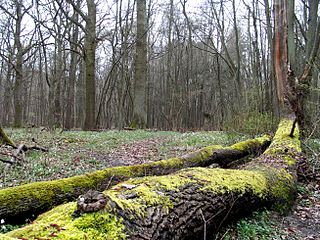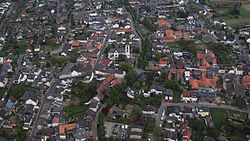
The federal city of Bonn (German pronunciation: [bɔn] is a city on the banks of the Rhine located in the German state of North Rhine-Westphalia, with a population of over 300,000. About 24 km south-southeast of Cologne, Bonn is in the southernmost part of the Rhine-Ruhr region, Germany's largest metropolitan area, with over 11 million inhabitants. It is a university city, was the birthplace of Ludwig van Beethoven and was the capital of West Germany from 1949 to 1990. Bonn was the seat of government of reunited Germany from 1990 to 1999.

Cologne is the largest city of the German western state of North Rhine-Westphalia (NRW) and the fourth-most populous city of Germany with 1.1 million inhabitants in the city proper and 3.6 million people in the urban region. Centered on the left (west) bank of the Rhine, Cologne is about 35 km (22 mi) southeast of NRW's state capital Düsseldorf and 25 km (16 mi) northwest of Bonn, the former capital of West Germany.

North Rhine-Westphalia, commonly shortened to NRW, is a state (Land) in Western Germany. With more than 18 million inhabitants, it is the most populous state of Germany. Apart from the city-states, it is also the most densely populated state in Germany. Covering an area of 34,084 square kilometres (13,160 sq mi), it is the fourth-largest German state by size.

Monheim am Rhein is a town on the right (eastern) bank of the river Rhine in North Rhine-Westphalia, Germany. Monheim belongs to the district of Mettmann – with the southern suburbs of Düsseldorf to the north, and the Bergisches Land to the south. It consists of the city districts Baumberg and Monheim.

Rees is a town in the district of Kleve in the state of North Rhine-Westphalia, Germany. It is located on the right bank of the Rhine, approximately 20 km east of Kleve. The population in 2005 was 22,559. Founded in 1228, Rees is the oldest town in the lower Rhine area.

Lohmar is a town in the Rhein-Sieg district, in North Rhine-Westphalia, Germany.

Rheinbach is a town in the Rhein-Sieg-Kreis district (Landkreis), in North Rhine-Westphalia, Germany. It belongs to the administrative district (Regierungsbezirk) of Cologne.

Alfter is a municipality in the Rhein-Sieg district, in North Rhine-Westphalia, Germany. It is situated approximately 6 km west of Bonn.

Porz is a borough or Stadtbezirk of Cologne, Germany. It is situated on the east side of the Rhine in the south-east of the city. Porz is the largest borough of Cologne by area at 78.92 km2 and has 113,500 inhabitants.

Bonn Hauptbahnhof is a railway station located on the left bank of the Rhine along the Cologne–Mainz line. It is the principal station serving the city of Bonn. In addition to extensive rail service from Deutsche Bahn it acts as a hub for local bus, tram, and Stadtbahn services.

The Swist is a stream, 43.6 kilometres (27.1 mi) long, in the German Rhineland. It rises on the northern edge of the Eifel at 330 metres above sea level and empties from the right and southeast into the Rhine tributary, the Erft, between Weilerswist and Bliesheim. Occasionally the Swist is also called the Swistbach, and locals often just call it der Bach.

Odendorf is a village in Germany, located in the municipality of Swisttal in the Rhein-Sieg district of North Rhine-Westphalia. The village is situated approximately 20 km (12 mi) southwest of Bonn. As of 2007, the village had 3,581 inhabitants.

The East Rhine Railway is a major, double-track, electrified railway line, running along the right bank of the Rhine from Cologne to Wiesbaden. The 179-kilometer (111.2 mi)-long line forms two Deutsche Bahn routes. Route 465 extends from Cologne to Koblenz, via Troisdorf, Bonn-Beuel, Unkel, and Neuwied. From Koblenz, Route 466 extends to Wiesbaden, via Rüdesheim am Rhein. Together with the Taunus railway, the line is used by Stadt-Express line SE-10 of the Rhine-Main Transport Association, which runs from Frankfurt to Koblenz and Neuwied.

The Ahr Hills are a range of low mountains and hills up to 623.8 m above sea level (NHN) and 25 kilometres (16 mi) long in the Eifel region of Germany, which lie roughly southwest of Bonn on the border between the German states of North Rhine-Westphalia and Rhineland-Palatinate.

The Voreifel is the name of a settlement area in the southern part of the German state of North Rhine-Westphalia. It is a term that grew out of the local speech.

The Ahr Valley Railway, Remagen–Ahrbrück, is currently a 29 km-long, partly single-track and non-electrified branch line, which runs through the Ahr valley from Remagen via Ahrweiler and Dernau to Ahrbrück in the German state of Rhineland-Palatinate. It is served by Regionalbahn services on lines RB 30 and RB 39.

The Voreifel Railway is a partly double track, non-electrified main line in the Voreifel from Bonn to Euskirchen in the German state of North Rhine-Westphalia.

The Kottenforst is a large forest, about 40 km² in area, to the south, west and north of the city of Bonn in Germany. It is part of the Rhineland Nature Park (1,045 km²) and forms its eastern side.

The Lower Germanic Limes is the former frontier between the Roman province of Germania Inferior and Germania Magna. The Lower Germanic Limes separated that part of the Rhineland left of the Rhine as well as the Netherlands, which was part of the Roman Empire, from the less tightly controlled regions east of the Rhine.
The Kreuz Meckenheim is a cloverleaf interchange that connects the Bundesautobahn 61 and 565 with each other. It is located in the south of the town of Meckenheim in the Rhein-Sieg-Kreis, a small piece on the southeast side is in the area of the neighboring municipality of Graftschaft in the Ahrweiler district (Rhineland-Palatinate).






















